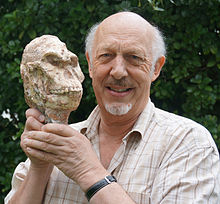Ronald J. Clarke
Ronald J. Clarke | |
|---|---|
 Ronald Clarke in 2015 | |
| Scientific career | |
| Fields | Paleoanthropology |
| Institutions | Johann Wolfgang Goethe University of Frankfurt am Main University of the Witwatersrand |
| Website | www |
Ronald J. Clarke is a paleoanthropologist most notable for the discovery of "Little Foot", an extraordinarily complete skeleton of Australopithecus, in the Sterkfontein Caves.[1] A more technical description of various aspects of his description of the Australopithecus skeleton was published in the Journal of Quaternary Science.[2]
He also discovered the Homo ergaster partial cranium SK 847.[3] He also played a role in the discovery of a new skeleton of Homo habilis related to Homo rudolfensis.[4]
He was associated with the University of the Witwatersrand, then joined Johann Wolfgang Goethe University of Frankfurt am Main in Frankfurt, Germany where he continued his work excavating "Little Foot".[5] He later rejoined the University of the Witwatersrand's Institute for Human Evolution, where he remains as of present.
See also
- List of fossil sites (with link directory)
- List of hominina (hominid) fossils (with images)
References
- ^ Bower, Bruce (1998). "Ancient ancestor reveals skeletal stamina". Science News. 154 (25/26): 389. doi:10.2307/4010879. JSTOR 4010879.
- ^ Partridge, Timothy C.; Shaw, John; Heslop, David; Clarke, Ronald J. (1999). "The new hominid skeleton from Sterkfontein, South Africa: age and preliminary assessment". Journal of Quaternary Science. 14 (4): 293. Bibcode:1999JQS....14..293P. doi:10.1002/(SICI)1099-1417(199907)14:4<293::AID-JQS471>3.0.CO;2-X.
- ^ Johanson, Donald and Edgar, Blake (1996) From Lucy to Language, New York:Simon & Schuster. p. 184. ISBN 0684810239.
- ^ Blumenschine, R. J.; Peters, C. R.; Masao, F. T.; Clarke, R. J.; Deino, A. L.; Hay, R. L.; Swisher, C. C.; Stanistreet, I. G.; Ashley, G. M.; McHenry, L. J.; Sikes, N. E.; Van Der Merwe, N. J.; Tactikos, J. C.; Cushing, A. E.; Deocampo, D. M.; Njau, J. K.; Ebert, J. I. (2003). "Late Pliocene Homo and Hominid Land Use from Western Olduvai Gorge, Tanzania". Science. 299 (5610): 1217–21. Bibcode:2003Sci...299.1217B. doi:10.1126/science.1075374. PMID 12595689.
- ^ "World-renowned Scientist sacked". geotoursafrica.com. 14 December 1998
External links
- Little Foot TalkOrigins Archive
- Full Australopithecus Fossil Found in South Africa (Washington Post)
- The Latest on “Little Foot’s” Bid for Status as Humanity’s Most Ancient Ancestor (April 16, 2015) (Answers in Genesis)

